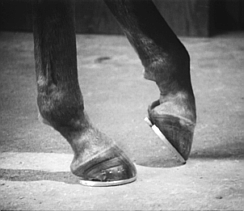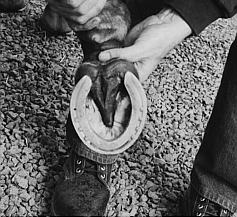 |
 |
© Walt Koepisch, Jr.
published in ANVIL Magazine, December 1996
It was during the latter part of the 1960's that I became familiar with aluminum horseshoes while being engaged as the official farrier at the National Horse Show at Madison Square Garden in New York City. Some of the European jumping teams were using aluminum horseshoes at that time. Also during that period some of the local farriers had started using aluminum. After experimenting for a couple of years myself, I had enough faith in what it could do that I formed a company to manufacture aluminum horseshoes. That was in 1972 and what has happened to aluminum horseshoes since then is now history. There aren't many professional trainers now who don't use aluminum on at least some of their horses.
In the beginning it was the hunters and jumpers that were being shod with aluminum but in time, the Quarter Horse industry became aware of the advantages of aluminum, and now the use of aluminum on Quarter Horses exceeds that of the other horses.
THE HORSE'S WAY OF GOING
I also show Quarter Horses, and so with the experience of showing horses, manufacturing horseshoes and being a farrier, I have the unique opportunity to see this subject from many angles and perhaps can offer some useful tips on shoeing the Quarter Horse with aluminum horseshoes. I have spent the past thirty years searching for ways to improve the horse's movement, so with that in mind I would like to explain what aluminum shoes can do and how to use them.
We know that loading a horse's foot with a lot of weight doesn't make the average horse move any prettier or run any faster. Light steel and then training plates have been tried through the years with varied results. Training plates just do not give enough support and protection to the average horse. Bruised soles and broken walls that don't hold shoes are the usual results. Handmade light steel shoes are a much better choice than training plates; however, steel doesn't possess all of the good features of aluminum.
COMPARED TO STEEL
Compared to steel, aluminum is soft to a horse's foot and so does not transmit as much sting to a horse's feet and legs - a very important consideration for a show horse. It is sort of like having a job where you have to stand on a concrete floor all day and then you change to a wooden floor. Both floors are hard, but the wood floor is so much easier on the legs. Since aluminum is one-third the weight of steel, it allows for good hoof protection without loading the horse with a lot of weight. Being able to add flotation to a shoe is another advantage that the pleasure horse trainers are starting to recognize. There are many other important reasons for using aluminum, but for now we will concentrate on just a few. If you were a horse, would you rather wear shoes made of spring steel, which transmits a lot of sting, or a shoe made of aluminum, which is very sting- absorbing? Hold a bar of aluminum in your hand and strike it on an anvil or hard surface and then do the same thing with a piece of steel. Aluminum dissipates sting much better than steel, and the horse will respond by moving smoother. An added benefit is that by reducing sting, we will reduce hoof damage caused by the horseshoes. Every time a shoe vibrates, it damages a little hoof wall.
By using a lighter material for our shoes we can use a shoe that has more flotation. Flotation is the amount of weight a shoe can support on the ground. A barefooted horse has a great amount of flotation. The whole foot is on the ground supporting the weight, but adding shoes reduces flotation unless a shoe with a wide web is used. A wide-web shoe made of steel gets pretty heavy, but with an aluminum wide-web shoe we can have the width and plenty of flotation without the extra weight.
MOVING EFFORTLESSLY
There are many ways to describe a pretty moving horse, but one definition is a horse that appears to move without using any effort. A pretty moving horse seems to glide over the ground without even touching it. By keeping a foot on top of the ground instead of in it, we can reduce the amount of effort the horse expends, therefore making the horse a prettier mover. That is the look we are trying to achieve when we shoe a pleasure horse: Make the horse seem to float.
Flotation can also be used on one side of the shoe to help balance a foot that carries more weight on one branch than on the other. The width of the shoe must be measured on the ground surface not the foot surface. If a shoe is sharply tapered to improve traction, it will allow a foot to go deeper into the arena and also make it stick. Neither will do much to improve the way a horse moves.
Flotation is also very important on the hind feet. If you expect a horse to carry more weight on the hind quarters and lope deeper, give the foot the ability to do that with a wide-web aluminum shoe behind. Try a high-flotation aluminum shoe behind; I think you will see an improvement.
 |
 |
WEAR
I saved one very important aspect of aluminum for last because it is a very important benefit, but the least understood. Simply put, it is wear. As a foot grows, the toe gets longer and the angle of the foot tends to lower. These two actions delay the breakover of the foot, changing the way the horse moves and putting strain on the suspensory system. The longer toe and lower angle change the hoof flight and also cause the horse to expend increased energy in moving forward - two negatives for a show horse.
This all happens slowly over the shoeing period, so you might not notice it. However, after about two weeks the change is enough to alter a horse's way of going. I don't think we want to reshoe our horses every two weeks. We can ask our aluminum shoes to come to the rescue. As the toe of the foot is getting longer (slowing the breakover) the toe of the shoe is wearing (speeding up the breakover). One tends to cancel out the other.
Did you ever have the experience of working a horse every day, then having the horse shod and riding him again right afterwards? Did the horse feel different? I have felt the difference because the hoof dimensions were restored, indicating that quite a few changes had taken place between shoeings. There was enough change to affect the way the horse moves. Using aluminum, you wouldn't see much change, if any. The horse will travel more constantly through the shoeing period - doing just as well on the last day of a long show series as on the first day. That gives the horse a tremendous advantage over his rivals. One caution however: Don't select a very hard aluminum shoe that is designed for endurance over a more forgiving shoe designed for show performance!
Competition in the show ring is getting tougher every year. As time goes by, it will be increasingly harder to win a class. The trainers and owners who constantly place well are the ones paying attention to the details. We all know how important the farrier is, but the proper shoes are just as important. This is the era of specialization, so it makes sense to use shoes that are designed especially for the specific event.
CONCLUSION
In conclusion, use aluminum to improve the horse's foot, to minimize hoof damage and to help the horse move most consistently throughout the shoeing period. Improve flotation to help the horse move freely with the least amount of effort in order to minimize the amount of weight a foot carries and to counteract the negative effects of hoof growth. Don't forget a high flotation shoe behind. Motion in a horse comes from behind. A flat knee, a long stride, a round back and a short frame are all dependent on what the hindquarters are doing. Give the hind feet the support needed to generate fluid, graceful, effortless motion. Choose horseshoes wisely and give yourself an edge.
Walt Koepisch runs Dutchtown Forge in Belle Mead, New Jersey.
Return to the Farriery Articles listing page.
Return to the ANVIL Online Table of Contents for December, 1996.